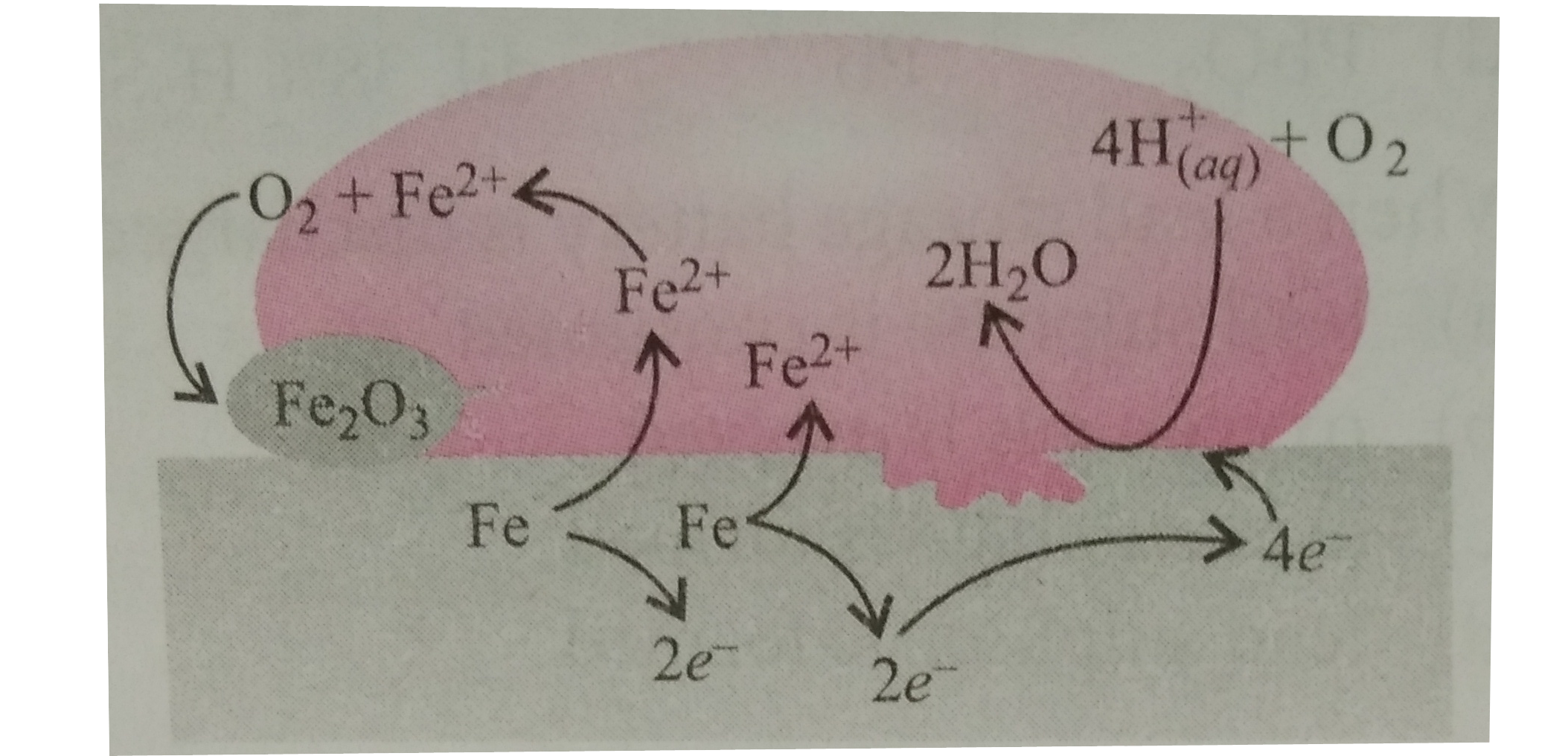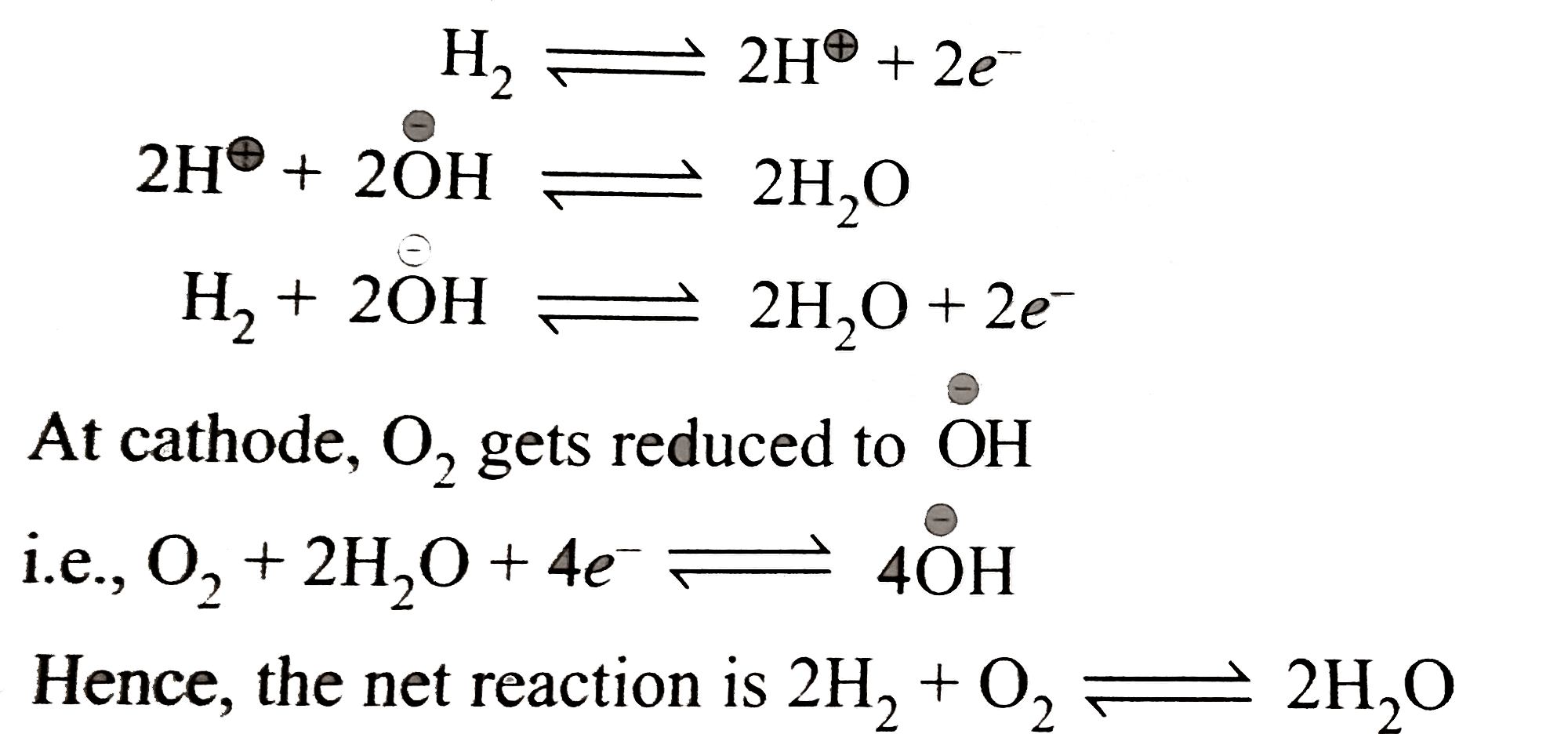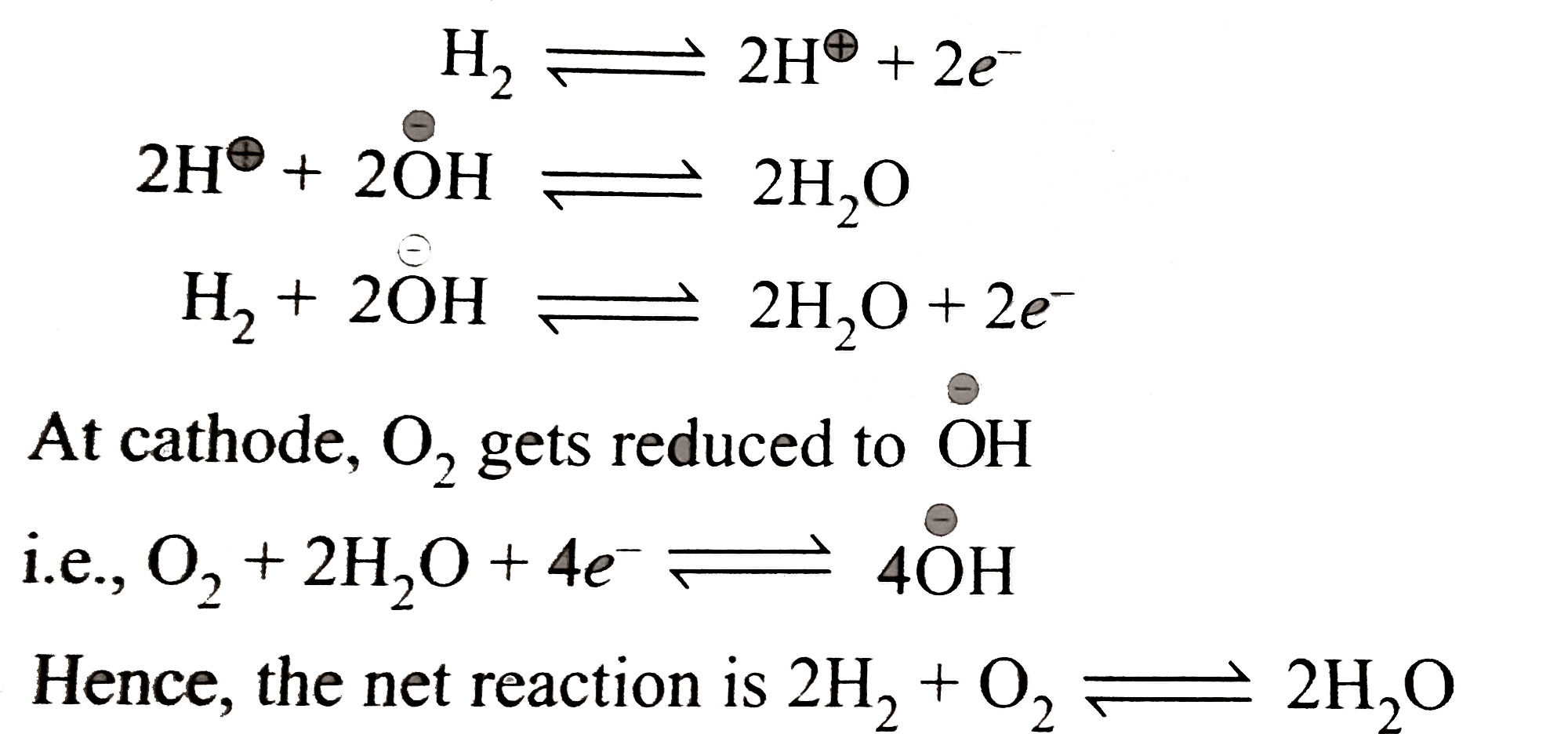Study the given cell carefully and fill in the blanks by choosing an appropriate option.
In the given cell, hydrogen and oxygen are bubbled through porous ___(i)___ electrodes into concontrated aqueous ____(ii)___ solution. Catalysts like finely dividend __(iii)__ or ___(iv)___ metal are incorporated into the electrodes for increasing the rate of electrode reactions.

i-hydrogen , ii-potassium hydroxide , iii-palladium , iv - platinum
i-oxygen , ii-hydrogen chloride , iii-manganese , iv-iron
i-carbon , ii-sodium hydroxide , iii-platinum , iv-palladium
i-graphite , ii-sodium chloride , iii-nickel , iv - platinum
The correct Answer is:C
Step by step video & image solution for Study the given cell carefully and fill in the blanks by choosing an appropriate option. In the given cell, hydrogen and oxygen are bubbled through porous ___(i)___ electrodes into concontrated aqueous ____(ii)___ solution. Catalysts like finely dividend __(iii)__ or ___(iv)___ metal are incorporated into the electrodes for increasing the rate of electrode reactions. by Chemistry experts to help you in doubts & scoring excellent marks in Class 12 exams.
Updated on:21/07/2023Topper's Solved these Questions
- ELECTROCHEMISTRYBOOK - NCERT FINGERTPS ENGLISHCHAPTER - ELECTROCHEMISTRYEXERCISE - HOTS
10 Videos
- ELECTROCHEMISTRYBOOK - NCERT FINGERTPS ENGLISHCHAPTER - ELECTROCHEMISTRYEXERCISE - EXEMPLAR PROBLEMS
17 Videos
- COORDINATION COMPOUNDS BOOK - NCERT FINGERTPS ENGLISHCHAPTER - COORDINATION COMPOUNDS EXERCISE - Assertion And Reason
15 Videos
- GENERAL PRINCIPLES AND PROCESSES OF ISOLATION OF ELEMENTSBOOK - NCERT FINGERTPS ENGLISHCHAPTER - GENERAL PRINCIPLES AND PROCESSES OF ISOLATION OF ELEMENTSEXERCISE - Assertion And Reason
15 Videos
Similar Questions
The given figure shows the corrosion of iron in atmosphere.

Fill in the blanks by choosing an appropriate option.
At a particular spot of an object made of iron, ___(i)___ of iron to ferrous ion takes place and that spot behaves as ___(ii)___. Electrons released at anodic spot move through the metal and go to another spot on the metal and reduce oxygen in presence of H+ . This spot behaves as ___(iii)___. The ferrous ions are further oxidised by atmospheric oxygen to ferric ions which come out as rust, __(iv)____ and with further production of ____(v)__ ions.
View SolutionFill in the blanks by choosing the appropriate word/words from those given in the brackets:
(hydrolysis, reduction, oxidation, vacant, osmotic, above, benzoic acid, phenol, aniline, below, can, decreases, increases, cannot, crystal, ionization, rate, rate constant.)
A catalyst ______ start a reaction but it can increase the ______ of the reaction.
View Solution
Knowledge Check
Fill the blanks in the given statements and select the correct option
A. The developmetnal stage of an animal passed in the mother's womb is called (i).____
(ii). The outer layer of blastula is called (ii). _____. It does nt take part in the formation of (iii). ______
C. (iv)._____ is the first germ layer formed from the inner cell mass by differentiation.A(ii)-mesoderm, (iii)-embryo proper (iv)-ectodermB(i)-embryo, (ii)-trophoblast, (iii)-embryo properC(i)-egg, (iv)-endodermD(i)-embyo- (iv)- ectoderm
Fuel cells : Fuel cells are galvanic cells in which the chemical energy of fuel cell is directly converted into electrical energy. A type of fuel cell is a hydrogen − oxygen fuel cell. It consists of two electrodes made up of two porous graphite impregnated with a catalyst ( platinum, silver, or metal oxide ). The electrodes are placed in aqueous solution of NaOH . Oxygen and hydrogen are continuously fed into the cell. Hydrogen gets oxidized to H⊕ which is neutralized by c−OH,i.e., anodic reaction.

At cathode, O2 gets reduced to c−OH

Hence, the net reaction is
The overall reaction has
ΔH=−285.6kJmol−1 and ΔG=−237.4kJmol−1 at 25∘C
If the cell voltage is 1.23V for the H2−O2 fuel cell and for the half cell :
View SolutionFuel cells : Fuel cells are galvanic cells in which the chemical energy of fuel cell is directly converted into electrical energy. A type of fuel cell is a hydrogen − oxygen fuel cell. It consists of two electrodes made up of two porous graphite impregnated with a catalyst ( platinum, silver, or metal oxide ). The electrodes are placed in aqueous solution of NaOH . Oxygen and hydrogen are continuously fed into the cell. Hydrogen gets oxidized to H⊕ which is neutralized by c−OH,i.e., anodic reaction.

At cathode, O2 gets reduced to c−OH

Hence, the net reaction is
The overall reaction has
ΔH=−285.6kJmol−1 and ΔG=−237.4kJmol−1 at 25∘C
If the cell voltage is 1.23V for the H2−O2 fuel cell and for the half cell :
View SolutionFuel cells : Fuel cells are galvanic cells in which the chemical energy of fuel cell is directly converted into electrical energy. A type of fuel cell is a hydrogen − oxygen fuel cell. It consists of two electrodes made up of two porous graphite impregnated with a catalyst ( platinum, silver, or metal oxide ). The electrodes are placed in aqueous solution of NaOH . Oxygen and hydrogen are continuously fed into the cell. Hydrogen gets oxidized to H⊕ which is neutralized by c−OH,i.e., anodic reaction.

At cathode, O2 gets reduced to c−OH
Hence, the net reaction is
The overall reaction has
ΔH=−285.6kJmol−1 and ΔG=−237.4kJmol−1 at 25∘C
Suppose the concentration of hydroxide ioin in the cell is doubled, then the cell voltage will be
View SolutionFuel cells : Fuel cells are galvanic cells in which the chemical energy of fuel cell is directly converted into electrical energy. A type of fuel cell is a hydrogen − oxygen fuel cell. It consists of two electrodes made up of two porous graphite impregnated with a catalyst ( platinum, silver, or metal oxide ). The electrodes are placed in aqueous solution of NaOH . Oxygen and hydrogen are continuously fed into the cell. Hydrogen gets oxidized to H⊕ which is neutralized by c−OH,i.e., anodic reaction.

At cathode, O2 gets reduced to c−OH
Hence, the net reaction is
The overall reaction has
ΔH=−285.6kJmol−1 and ΔG=−237.4kJmol−1 at 25∘C
What is the value of ΔSc− for the fuel cell at 25∘C?
View SolutionFuel cells : Fuel cells are galvanic cells in which the chemical energy of fuel cell is directly converted into electrical energy. A type of fuel cell is a hydrogen − oxygen fuel cell. It consists of two electrodes made up of two porous graphite impregnated with a catalyst ( platinum, silver, or metal oxide ). The electrodes are placed in aqueous solution of NaOH . Oxygen and hydrogen are continuously fed into the cell. Hydrogen gets oxidized to H⊕ which is neutralized by c−OH,i.e., anodic reaction.

At cathode, O2 gets reduced to c−OH
Hence, the net reaction is
The overall reaction has
ΔH=−285.6kJmol−1 and ΔG=−237.4kJmol−1 at 25∘C
What is the value of ΔSc− for the fuel cell at 25∘C?
a.−1600JK−1
b.−160JK−1
c.160JK−1
d.1600JK−1
View SolutionFuel cells : Fuel cells are galvanic cells in which the chemical energy of fuel cell is directly converted into electrical energy. A type of fuel cell is a hydrogen − oxygen fuel cell. It consists of two electrodes made up of two porous graphite impregnated with a catalyst ( platinum, silver, or metal oxide ). The electrodes are placed in aqueous solution of NaOH . Oxygen and hydrogen are continuously fed into the cell. Hydrogen gets oxidized to H⊕ which is neutralized by c−OH,i.e., anodic reaction.

At cathode, O2 gets reduced to c−OH
Hence, the net reaction is
The overall reaction has
ΔH=−285.6kJmol−1 and ΔG=−237.4kJmol−1 at 25∘C
A fuel cell is
I. A voltaic cell in which continuous supply of fuels are sent at anode to perform oxidation.
II. A voltaci cell in which fuels such as :CH4,H2, and CO are used up at anode.
III. One which involves the reaction of H2−O2 fuel cell such as :
Anode :2H2O+4c−OH→4H2O(l)+4ec−
Cathode :O2+2H2O(l)=4e−→4c−OH
IV. The efficiency of H2−O20 fuel cell is 70 to 75%
View SolutionDraw the diagram a of galvanic cell involving following reactions :
Zn+Cu+→Zn2++Cu and answer the following questions:
(i) Label the cathode and anode
(ii) How does the e.m.f. of the cell changes with the decrease in the concentration of Cu2+ ions ?
(iii) What is the function of salt bridge in it?
(iv) Name the salt to be used in salt bridge.
(v) Write the reactions occurring at each electrode.
(vi) In which direction the electrons would flow in the external circuit?
(vii) How electrical neutrality is maintained in both the half cells?
View Solution
